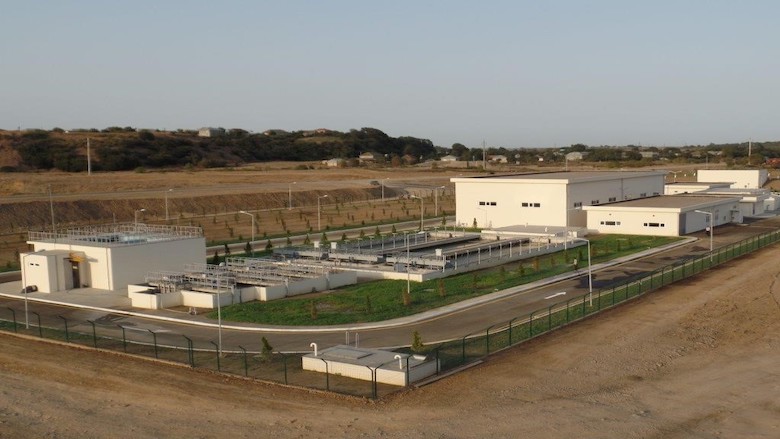Challenge
Azerbaijan inherited an extensive water supply system built during the Soviet era. However, the condition of the water system gradually deteriorated due to a lack of investment and deferred maintenance, resulting in a substantial decrease in the quality and reliability of the water supply service. In many small towns, prior to the implementation of the project, water treatment facilities were largely dysfunctional or nonexistent - to the extent that the residents in these towns did not have access to a safe water supply. Furthermore, most rayons (districts) did not have functioning sewerage collection services, the few available facilities were in disrepair, and utilities were technically and financially unsustainable. This was a serious threat to public health and the environment.
Approach
To address these challenges, the project financed investments to rehabilitate and reconstruct the whole water services cycle—including (i) water supply and storage systems, (ii) the sewage network and (iii) wastewater treatment in the selected districts. This was a unique approach sought to improve people’s lives, but also to strengthen environmental protection and future operations and maintenance.
To ensure sustainability, the project also focused on building utilities’ capacity in financial and technical management. A new Hovsan Training and Innovation Center was established where local operational teams were provided with on-the-job training that focused on improving operations and maintenance, transparency, tariff collection and accountability.
The project also aligned with the government’s commitment to reduce regional inequalities and providing households in rural areas with reliable basic services as outlined in the Third State Program of Social and Economic Development of Regions for 2014-2018. By aligning with the government priorities, the project sought to achieve greater sustainability and impact at scale.
Results
The project has provided 324 000 Azerbaijanis with improved water supply and sanitation services between 2008-2019. Results in the selected project rayons over the course of implementation included:
98 percent of the population in the project area gained access to water for 24 hours a day compared to the baseline of 3 hours prior to the project. Water reservoir capacity increased by 35,000 cubic meters and new water treatment facilities were built. In all participating rayons, 98 percent of drinking water samples from the project areas now meet national water quality standards.
Over 46,000 households gained access to a new piped water network, and 43,000 new households were connected to a new sewerage network.
324,000 people received improved water supply, of which 160,000 were female.
1,224 kilometers of water network was rehabilitated, and 980 kilometers of sewerage network was rehabilitated.
A new Hovsan Training and Innovation Center was established, which now trains over 3,000 people a year on water supply and sanitation management, power engineering, automation and more.
Over 140 personnel in all participating rayons were trained on operation and maintenance, accountability and financial management.
Bank Group Contribution
The total project cost of US $641.8 million was financed by an International Development Association credit of US $30 million, an International Bank for Reconstruction and Development contribution of US $380 million, and a Government of Azerbaijan contribution of $234 million.
Partners
The project was part of the government’s country-wide $4 billion Azerbaijan Water Program which aimed at reducing regional inequalities and providing households in all rayon centers with reliable basic services, such as water and sanitation and other communal services. The national program was also supported by several development partners such as the Asian Development Bank, KfW (a German state-owned development bank), Islamic Development Bank, and Japan International Cooperation Agency.
The project had also developed a close partnership with government agencies, including:
Ministry of Ecology and Natural Resources.
AZERSU Open Joint Stock Company - a government-owned national water supply, and sanitation operator.
State Amelioration and Water Management Agency.
Moving Forward
Providing reliable water and sanitation services is one of the top priorities for Azerbaijan’s development policy, and the experience provides opportunities for peer-to-peer learning in which service providers from project targeted areas share their experiences with their peers across the country. The World Bank’s Water Global Practice envisions continued engagement with the sector to support further improvements in the efficiency and quality of water supply and sanitation services in Azerbaijan and beyond.
Beneficiaries
The project has provided over 324,000 Azerbaijanis with water and sanitation services and a reliable supply of treated water.
“For 23 years that I’ve lived here, this street didn’t have water, we were asking God for real clean water in our houses—not coming from a tank truck—so finally, when we got this water, it was a huge blessing!” says Reyhan Badalova from Siyazan, a rural district north of Baku.
“We used to use water only drop by drop,” says Sevinj Novruzova from Siyazan as she washes pots in her kitchen. “And we had to be really careful with it. But now we have water and that allows us to keep the house clean. Oh, and we used to bring water in by bucket from other places, and now look!” she says, turning on the tap.
Learn More
Second National Water Supply and Sanitation Project portal
World Bank Global Water Practice related materials
In Azerbaijan: The life-changing impact of water
Multimedia
Photo 1: For decades, people in Siyazan, Azerbaijan got their water in trucks, and kept it in barrels outside. Photo Credit: World Bank
Photo 2: Today, there is clean running water inside the houses for washing up, bathing, and keeping things clean. Photo Credit: World Bank
Short movie capturing voices of some of the project beneficiaries: https://www.youtube.com/watch?v=ixqKjJDCREM
Published: October 2017


